
We’re revealing exclusive data from the first half of 2025, based on our $750M+ worth of listings, analyzing the most in-demand brands and watch styles, the prevalence of inauthentic watches on the secondary market, and how Bezel provides the best experience not only for buyers but also for sellers.

Welcome to the H1 2025 Bezel Report! The team and I have had a blast diving into thousands of purchases, millions of user interactions, and hundreds of millions of dollars in active listings on the platform to compile this report.
At Bezel, our goal has always been to create the most trusted platform for buying, selling, and collecting watches. We’ve quickly learned that doing so transparently and sharing market insights is something that resonates with our collector community. As we continue to grow, we’re committed to consistently sharing our learnings on authentication processes, purchase behavior, market trends, consumer preferences, and more in these Bezel reports.
I hope you find the data as interesting as we do. As always, please reach out to your Client Advisor (directly in the Bezel app or website) if you have any questions, thoughts, or requests for the next report.
Although the secondary market for luxury watches is inherently built on trust, that trust is often undermined by the presence of counterfeiters and individuals seeking to pass off modified watches as entirely genuine. In light of this complex truth, we continually work to remove the guesswork from the luxury watch-buying experience, ensuring authenticity with ease through the considered verification of every watch sold on the platform.
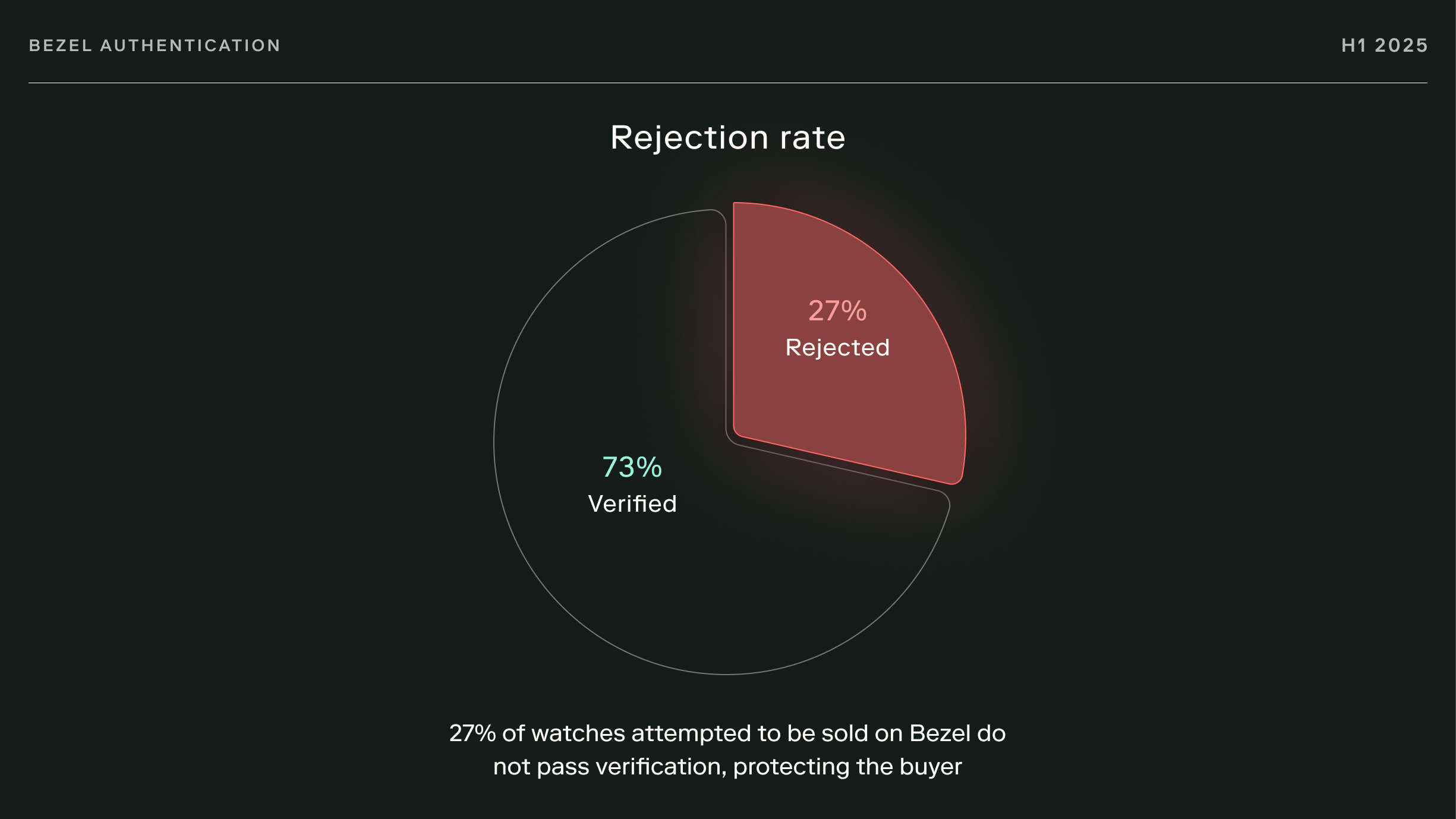
Throughout the first half of 2025, our authentication team rejected 27% of listings attempted to be sold on the platform for a myriad of reasons, including, but not limited to, the presence of outright counterfeits, the use of non-authentic or non-period-correct components, discrepancies between the described and actual condition, and functional or diagnostic failures. Of the 27% of listings attempted to be sold, 38% of those watches were listed for more than $10,000.
By holding every listing and transaction to an industry-leading standard, we afford buyers the confidence to collect without apprehension, reinforcing trust, integrity, and an unending commitment to excellence.
We’re resolutely committed to safeguarding buyers from transacting on watches produced by a wide variety of brands by rejecting pieces that fail to meet our industry-leading authentication standards. Logically, the breakdown of rejections by brand over the last six months closely follows the hierarchy of top watchmakers in today’s market, reflecting a rational correlation between market demand and incentive for counterfeiting and deceptive practices. Additionally, Ryan Chong, our Chief Marketplace Officer, notes, “Watches that fail our authentication often lack correct descriptions in the original listing. In-hand, watches may not match their aesthetic condition, or they may not include crucial descriptions of elements that affect the value and desirability of the watch, such as swapped components and parts.”
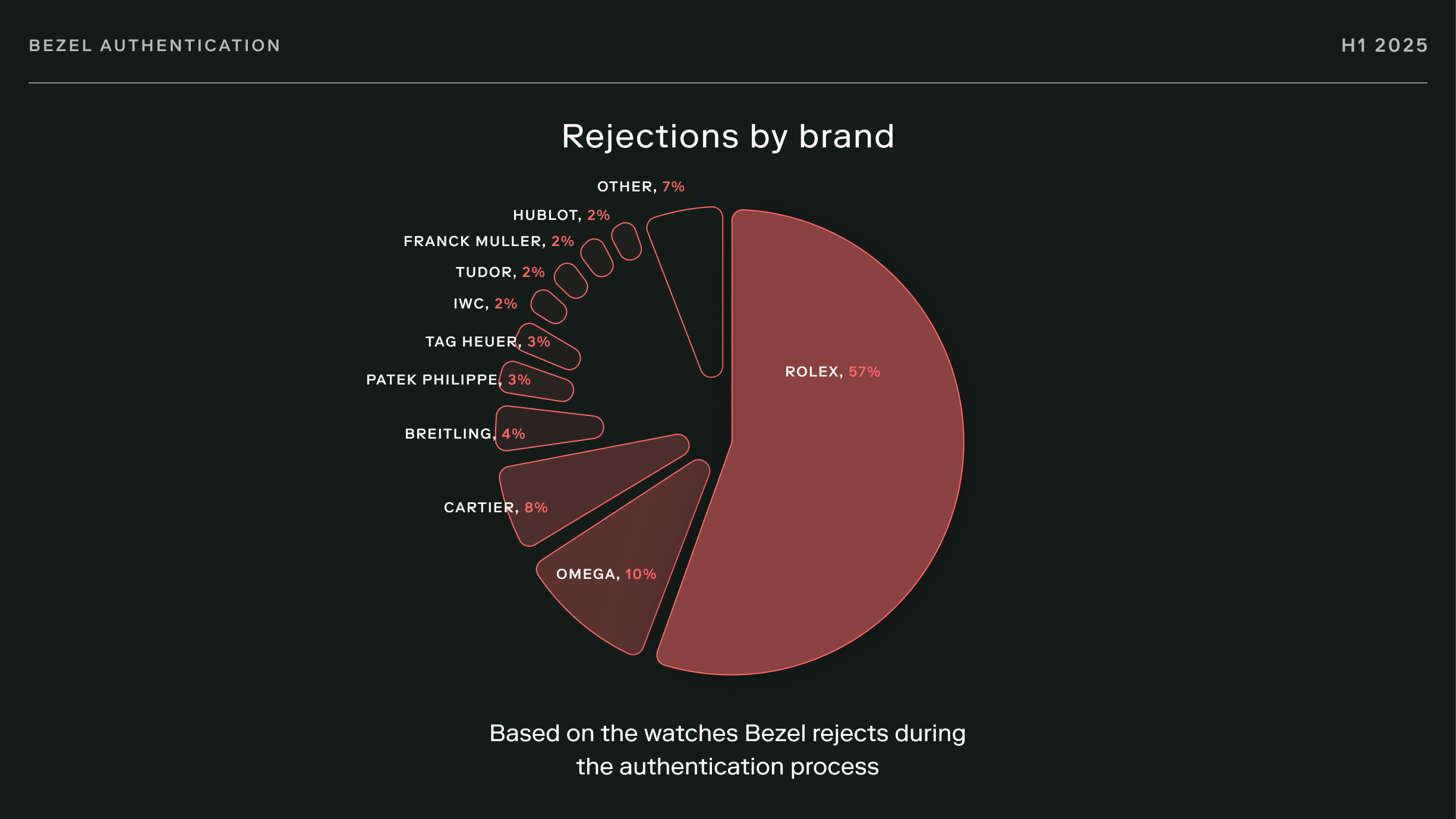
In comparing this latest data set to that of the 2024 Bezel Report, Rolex understandably continued to represent the most often rejected brand on Bezel, as a result of the watchmaker’s immense international renown, and the consequently outsized incentive for counterfeiting. Comparison also exhibited a significant decline in TAG Heuer rejections, dropping from 34% to just 3% in the first half of 2025. This significant improvement can be attributed to the removal from circulation of a substantial batch of issue watches that we saw in 2024.
Additionally, Omega experienced a steady increase in rejections after having previously not registered within the Top 10 of H1 2024’s data set. The rejections then climbed to 5% of rejections by brand by the end of the year, and subsequently doubled to 10% over the last six months. We ultimately attribute this increase to the growing popularity of Omega’s recent releases, resulting in greater demand and therefore, a higher number of watches circulating through the market.
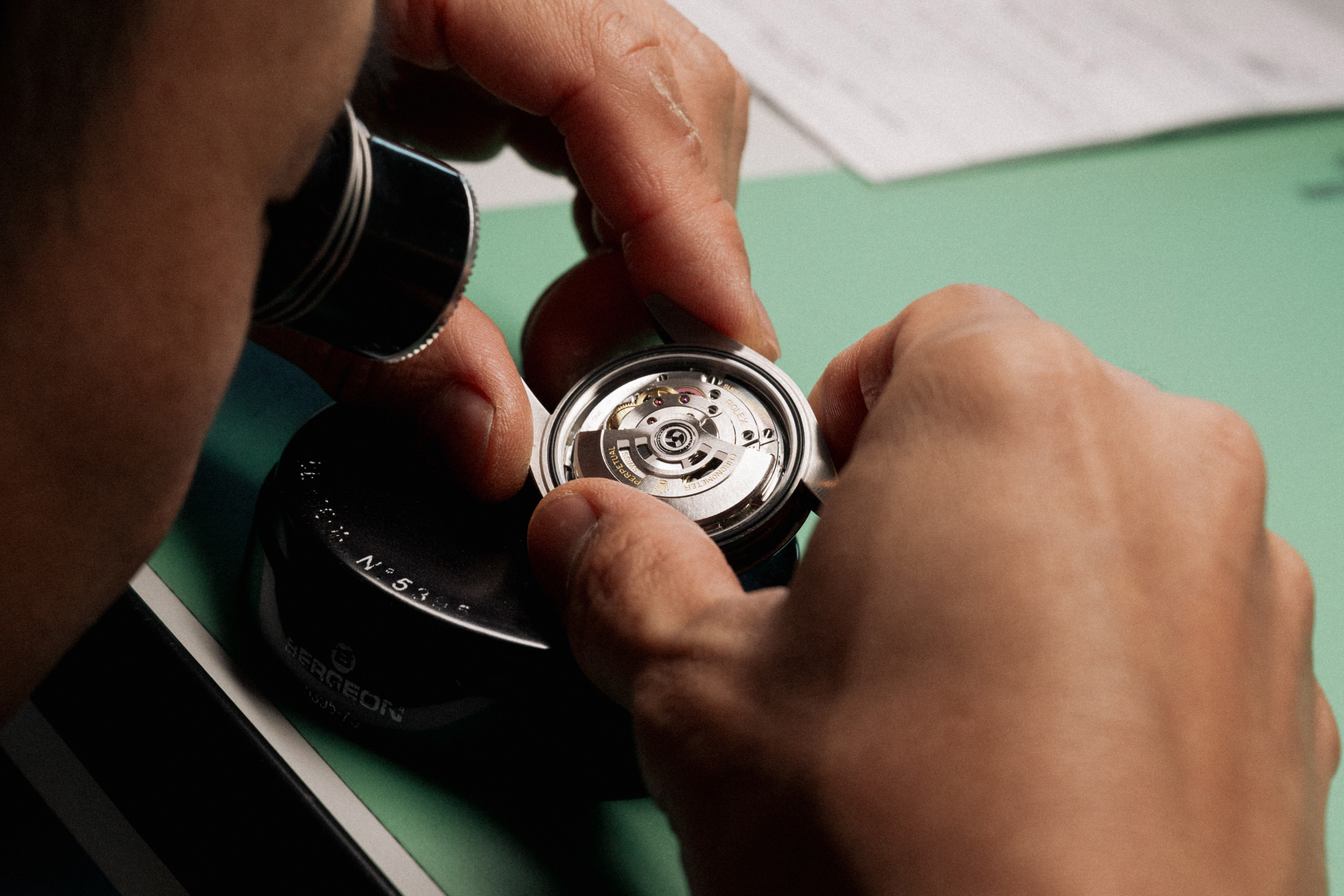
The reference 126300-0005 Rolex Datejust 41 is something of an outlier within Datejust collecting circles, deviating from perhaps conventional tastes with its more restrained smooth bezel, stark white dial, and Oyster bracelet. Offering an altogether more sporty take on the legendary pioneer of date-equipped watchmaking, this example’s attempted sale on Bezel didn’t just reinforce the individuality afforded by Rolex’s wide variety of Datejust 41 configurations; it shed light on a deceptive practice in today’s watch trading landscape.
Upon initial inspection by our in-house team of authenticators, this endlessly versatile icon raised no eyebrows, appearing as a perfectly normal, undeniably alluring, and altogether genuine example of the famed Rolex Datejust 41. However, upon analysis of its case markings and serial number engravings, a more inconsistent story began to emerge.
After running the serial number through our databases, it was revealed that our authentication team had previously rejected the very same watch at an earlier date, having discovered a series of non-period-correct parts at the time of its initial attempted sale. During the inspection process following its second attempted sale, the team discovered that the non-period-correct parts in question had since been swapped with period-correct parts, and moreover, its dial had been swapped from an “Azzuro Blue” dial to a white stick dial. Consequently, our authentication team concluded that the example was altogether untrustworthy, resulting in the cancellation of this latest sale.
Despite the fact that the watch in question was comprised of genuine components, its repeated tampering rendered it an inherently dishonest watch, one that, if sent to Rolex for service, would have been refused on the grounds of third-party modification. As Ryan Chong explains, “When a watch is under the manufacturer’s warranty, we use all the tools and resources we have available to confirm that the watch will be covered under that warranty. Typically, when a dial and/or movement is swapped and it differs significantly from the original format of the watch, there’s a strong chance that warranty would be void.”
Beyond closely scrutinizing every watch sold on Bezel in detail, our authentication team assesses every accessory included with each watch, examining for indicators of authenticity, period-correctness, overall condition, and more. Given that more than half of the requests received by our concierge team are for “full-sets,” typically commanding a roughly 10% premium over watch-only examples, this stage of the authentication process is of crucial importance. This notion is perhaps best illustrated by recounting the authentication of a Rolex Yacht-Master 40, in which the evaluation of its included accessories made all the difference and ultimately prevented the purchase of a misrepresented watch.
Following this example of the reference 126621-0002’s inspection, our expert team of authentication specialists and watchmakers confidently deemed it to be 100% authentic and proceeded to assess its all-important warranty card, both its outer and inner boxes, and finally the included product literature. While all of its corresponding accessories were indeed authentic, an authentication specialist quickly spotted signs of tampering on the portion of the warranty card that indicates the reference and serial numbers.
While the date of sale and warranty activation on the card in question read “10.04.2024,” the sighting of prominent surface texture inconsistencies led to speculation that the date had been “wiped,” meaning that the original date had been carefully removed and re-printed with a later date so as to increase desirability, and suggest a still-active or lengthier warranty period than in actuality. Through the use of high-magnification loupes, black lights, and a variety of different lighting sources, our authentication team discovered a residual imprint left by the original date printing, which read “4.10.2022,” over 2 years earlier than the card had deceptively suggested.
Unfortunately, this practice has become increasingly common in the sale of pre-owned Rolex watches on the secondary market, further reinforcing the importance of carefully scrutinizing even the smallest details.
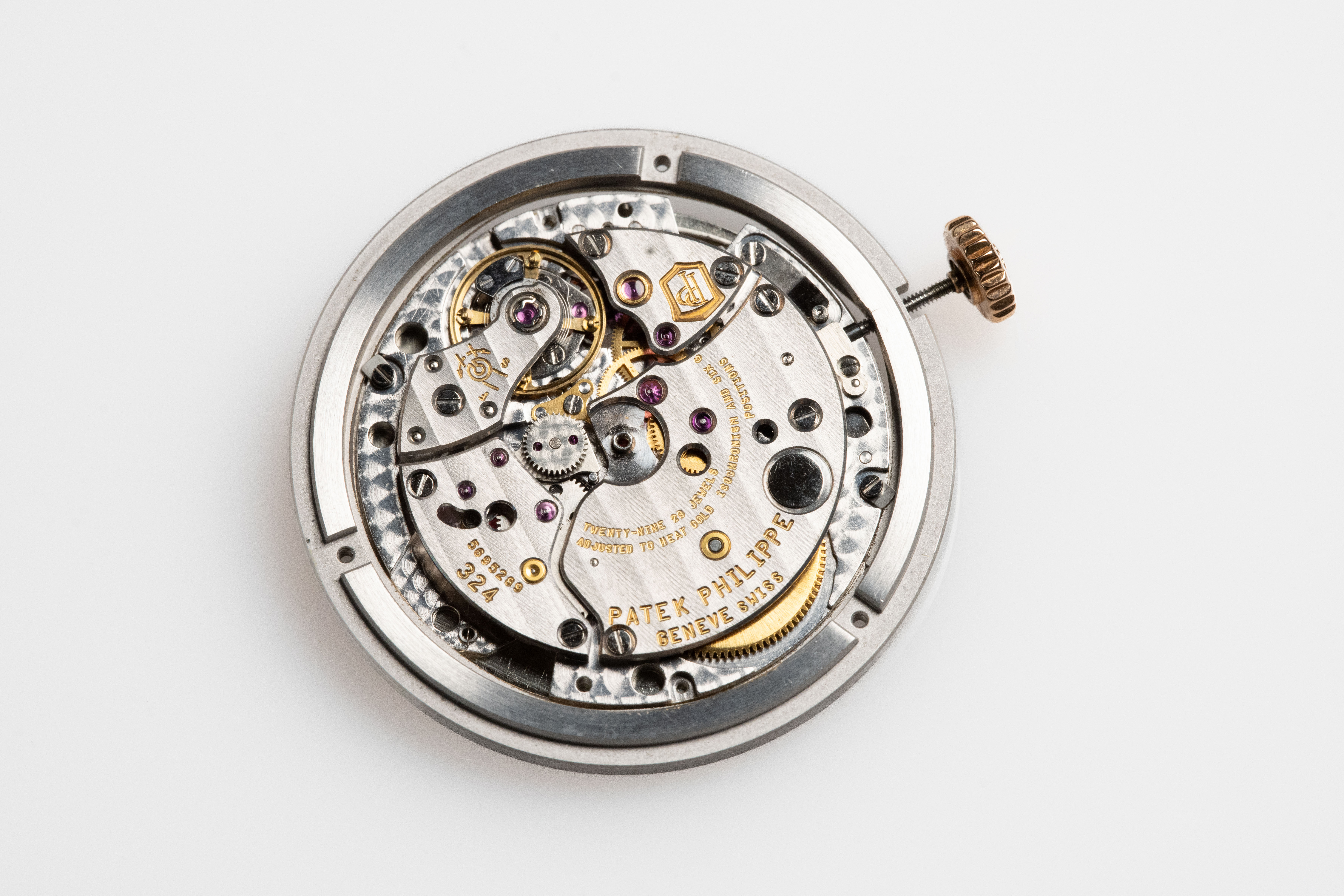
Within the world of watch collecting, pieces composed of a combination of genuine and counterfeit components are colloquially referred to as “frankenwatches.” Despite the perhaps playful nature of this term, these watches burden the market at large, establishing a perilous grey area that comes with costly consequences for those who unknowingly engage. Well aware of these deceptive timepieces, our in-house authentication team is committed to assessing the entirety of each watch that’s transacted upon in a comprehensive manner.
This ceaseless commitment to detail-oriented verification proved especially worthwhile during the authentication of a Patek Philippe Calatrava Ref. 5296R-010, which ultimately proved to be one such frankenwatch. After a series of multi-point inspections, performance testing procedures, and considered comparisons against already verified, genuine examples, it was determined that the movement powering the watch in question was counterfeit, albeit an exceedingly convincing clone of Patek Philippe’s self-winding Caliber 324 SC.
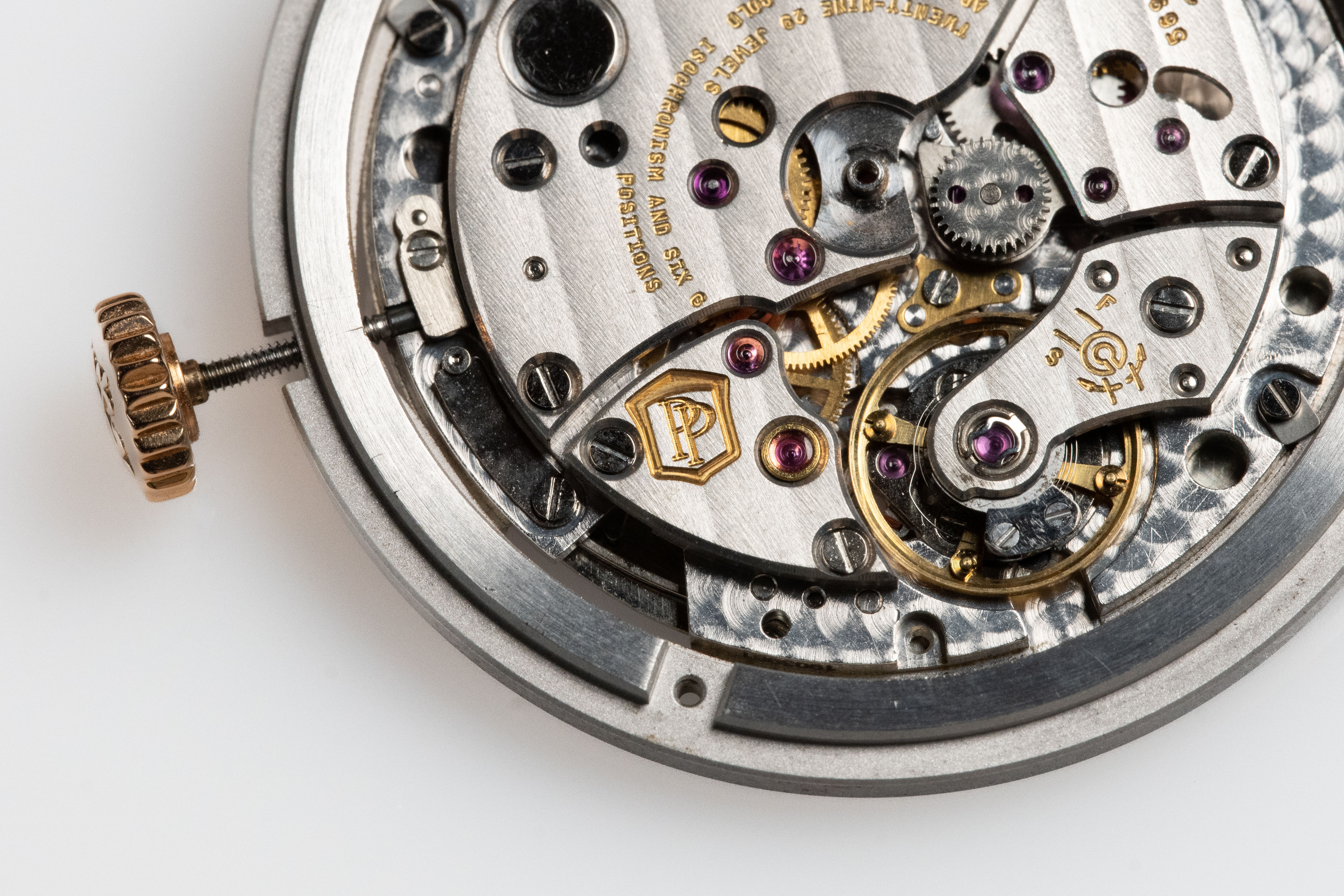
Given the presence of a counterfeit component, and an exceptionally important one at that, the watch was rejected, its sale was canceled, and the prospective buyer was protected from unwittingly purchasing a compromised timepiece.
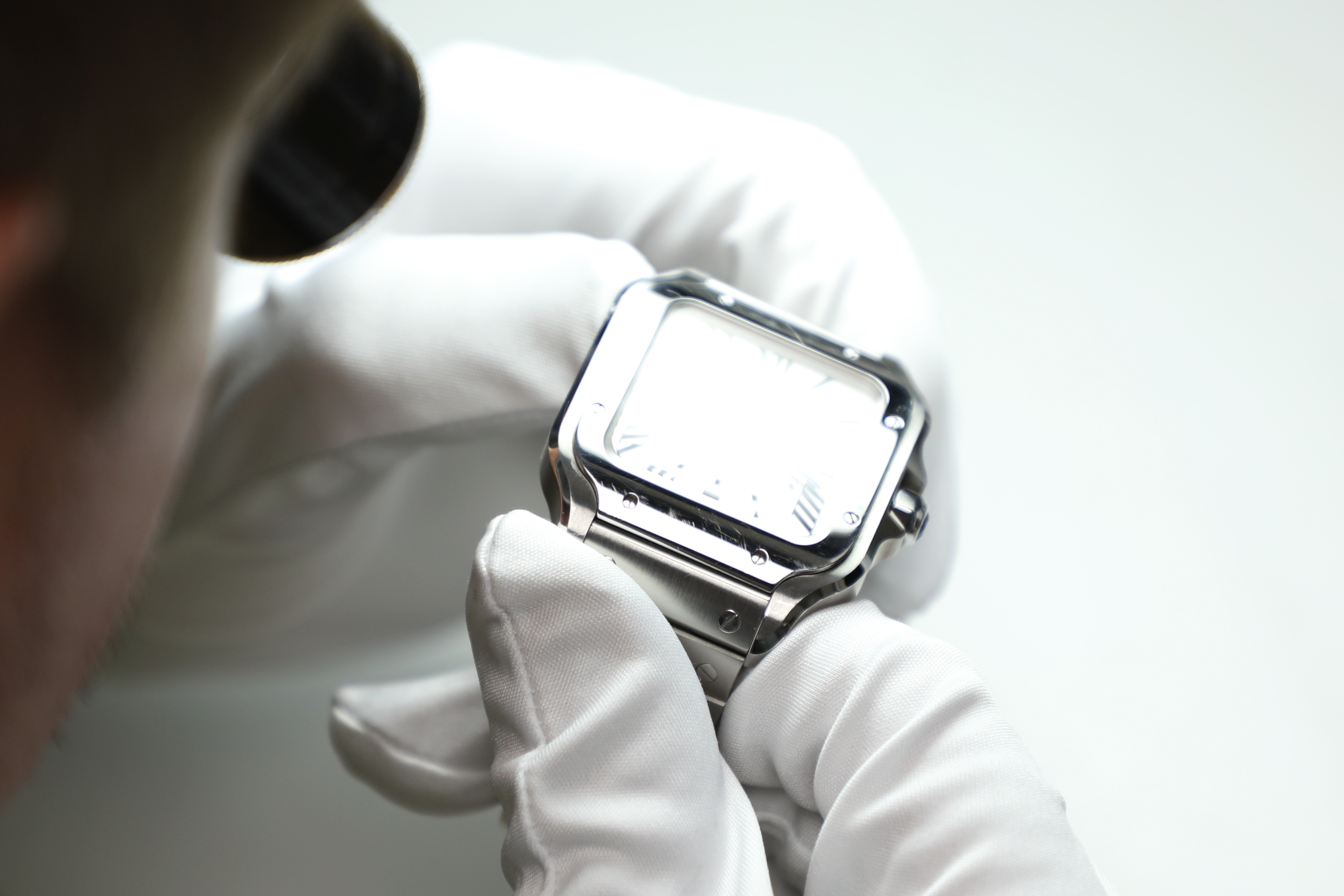
Like any other sought-after collectible, the pricing of a secondhand luxury watch is highly dependent on its condition, with well-preserved examples naturally commanding higher figures than those showing signs of heavy wear. That’s why our in-house authentication team assesses the condition of every watch in detail, ensuring that every watch transacted upon is sold in a transparent manner that accurately reflects its present condition.
Following the arrival of a factory ADLC-coated Cartier Santos 100 at Bezel, it was discovered that, despite being entirely authentic, the structural integrity of its alligator strap had been compromised after years of regular wear. As a result, the previous owner used an adhesive to secure one end of the strap in place at the lugs, due to the erosion of its end-piece insert.
Considering that the seller didn’t note this flaw in the original listing and how it significantly impacted the watch's robustness when worn on the wrist, the watch was rejected, its sale was cancelled, and our concierge team stepped in to assist with sourcing another example.
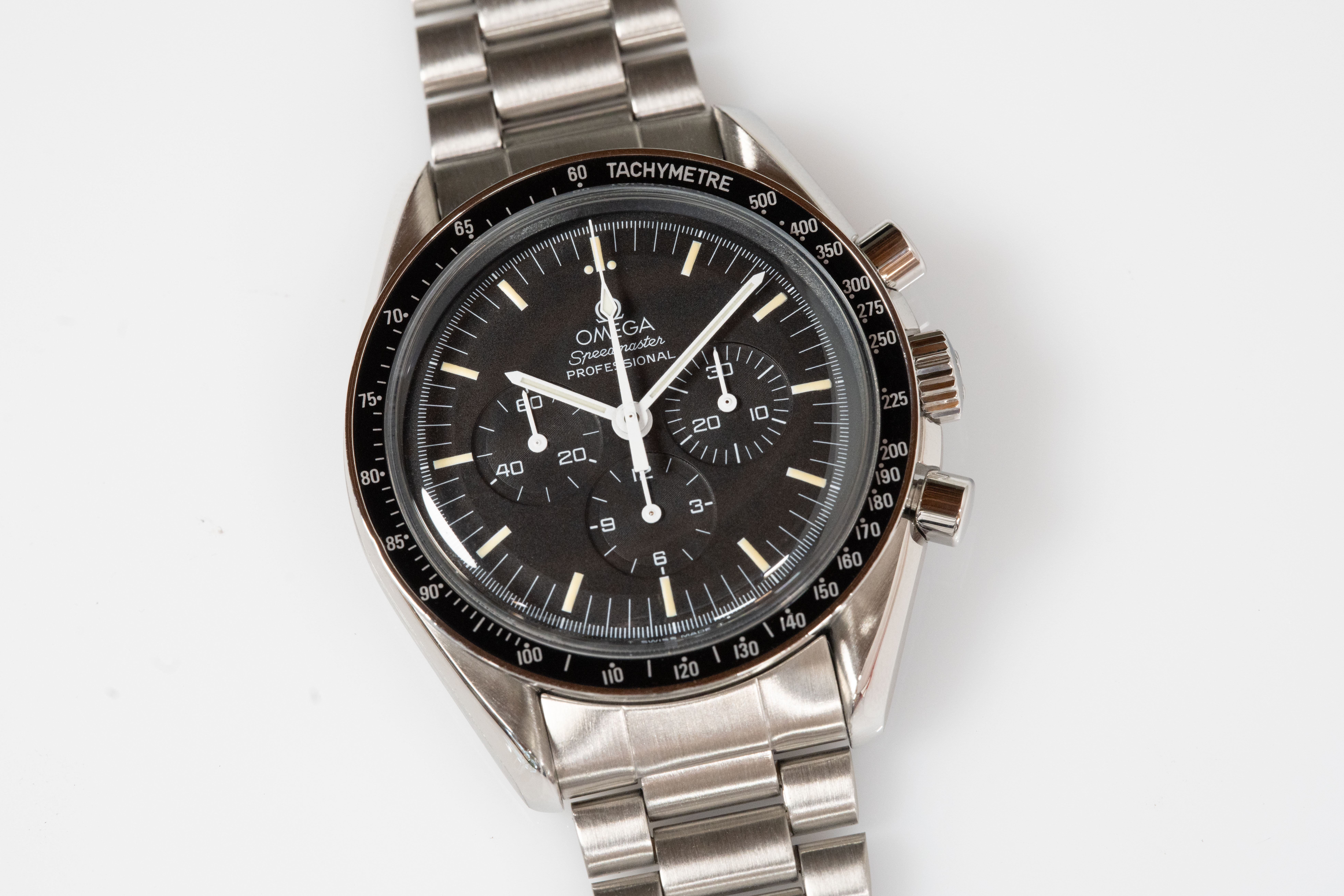
In addition to examining each watch to verify authenticity, our in-house team of watch experts and authenticators takes pride in ensuring that every watch sold on the platform is the rightful property of its seller and acquired under lawful circumstances. With this in mind, the serial numbers of every watch sold on Bezel are run through the largest database for lost and stolen watches to confirm there are no matches, protecting buyers from unknowingly acquiring stolen property.
While inspecting a Breitling chronograph from the brand’s partnership with British luxury automaker Bentley, the aforementioned safeguarding measure proved futile upon discovering that this example's serial number had previously been completely polished off its caseback, leaving no trace of its single most vital identifying feature. This same issue was encountered during the authentication of an Omega Speedmaster Professional “De Luxe,” which was rendered similarly untraceable at the mercy of the polishing wheel.
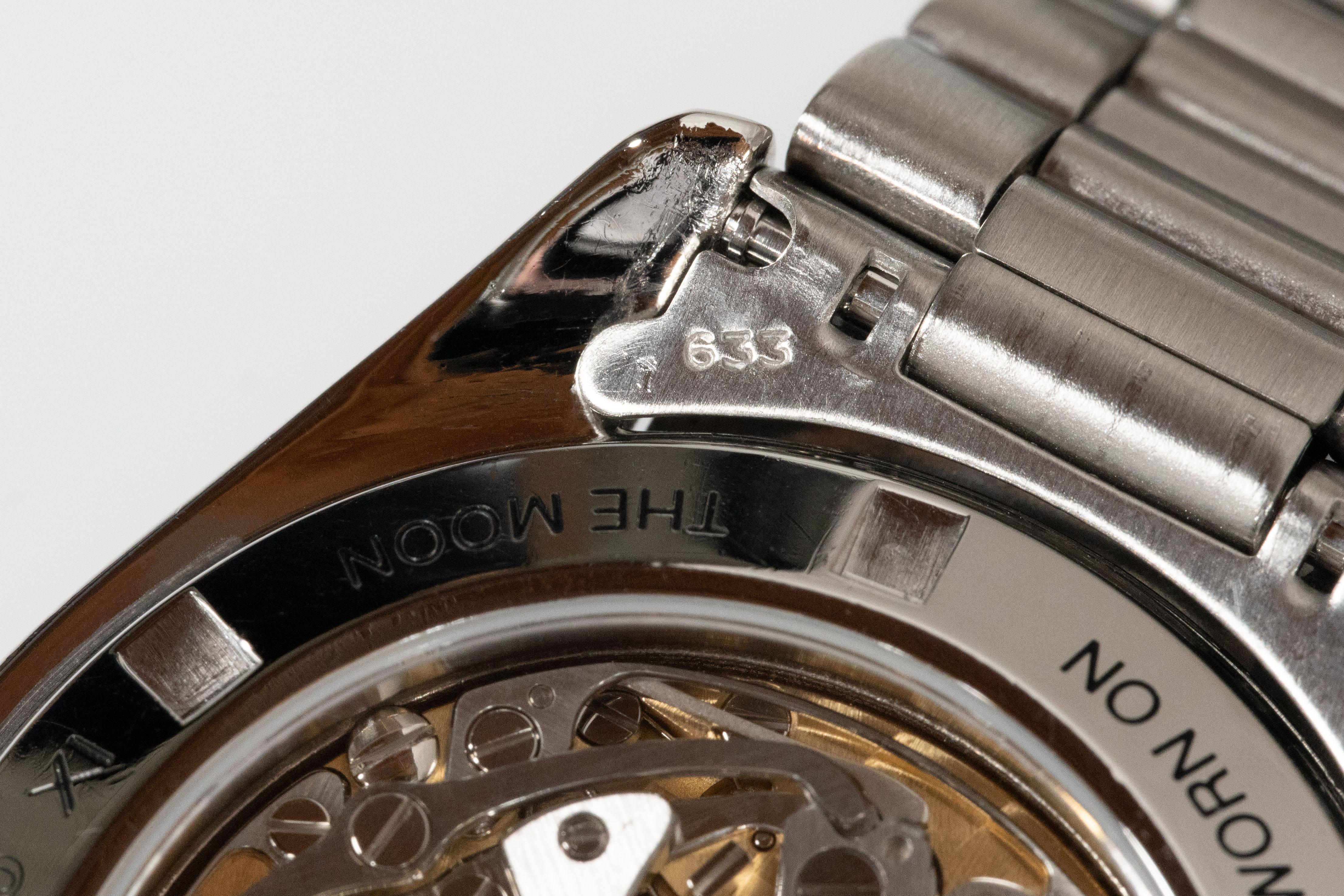
Although it was unclear whether the Breitling or the Omega was in fact stolen or simply polished excessively by an uninformed technician, the impossibility of distinction proved too great a risk to allow these watches to be transacted upon, resulting in their rejection and the cancellation of their respective sales.
Our H1 2025 data reveals how brand preferences translated from collector interest to actual purchases. To little surprise, Rolex maintained its commanding position, accounting for 37% of wants and 33% of sales. The strength of these figures is indicative of Rolex’s unmatched status as both an aspirational icon for collectors and a consistent market leader in actual sales.
Omega watches accounted for 12% of wants and 15% of transactions, demonstrating how consistent secondary market availability can drive sales beyond initial interest levels.
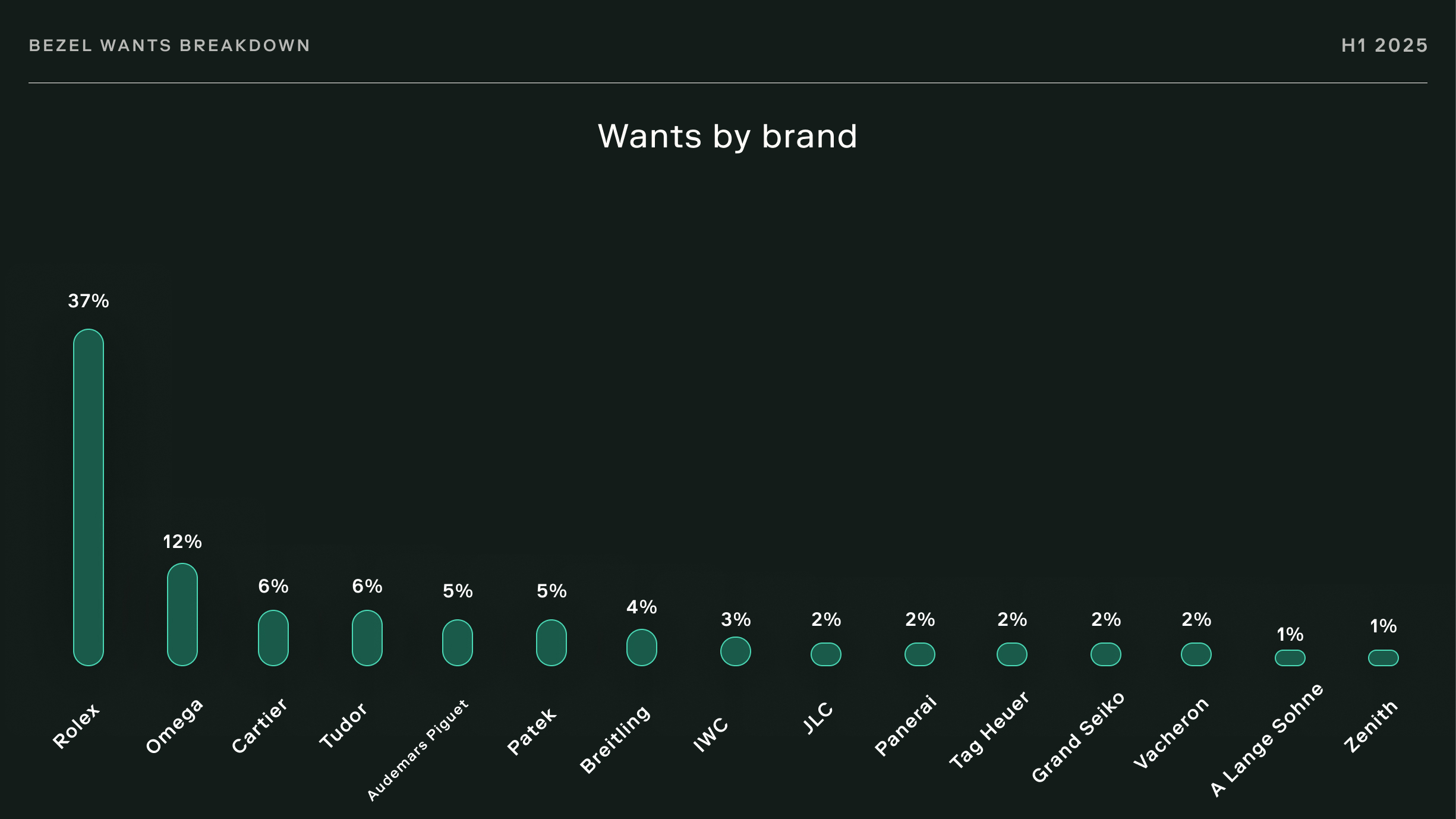
Tudor's performance stands out as the real winner here, securing 6% of wants and 12% of sales, highlighting how strongly the brand's value proposition resonates with collectors. With the passing of each and every day, more buyers continue to resonate with Tudor's legitimate Swiss provenance and the sort of credibility that’s synonymous with being Rolex's sister brand. As Rolex's accessibility continues to decline, Tudor's positioning as a relatively accessible Swiss luxury brand appears increasingly compelling.
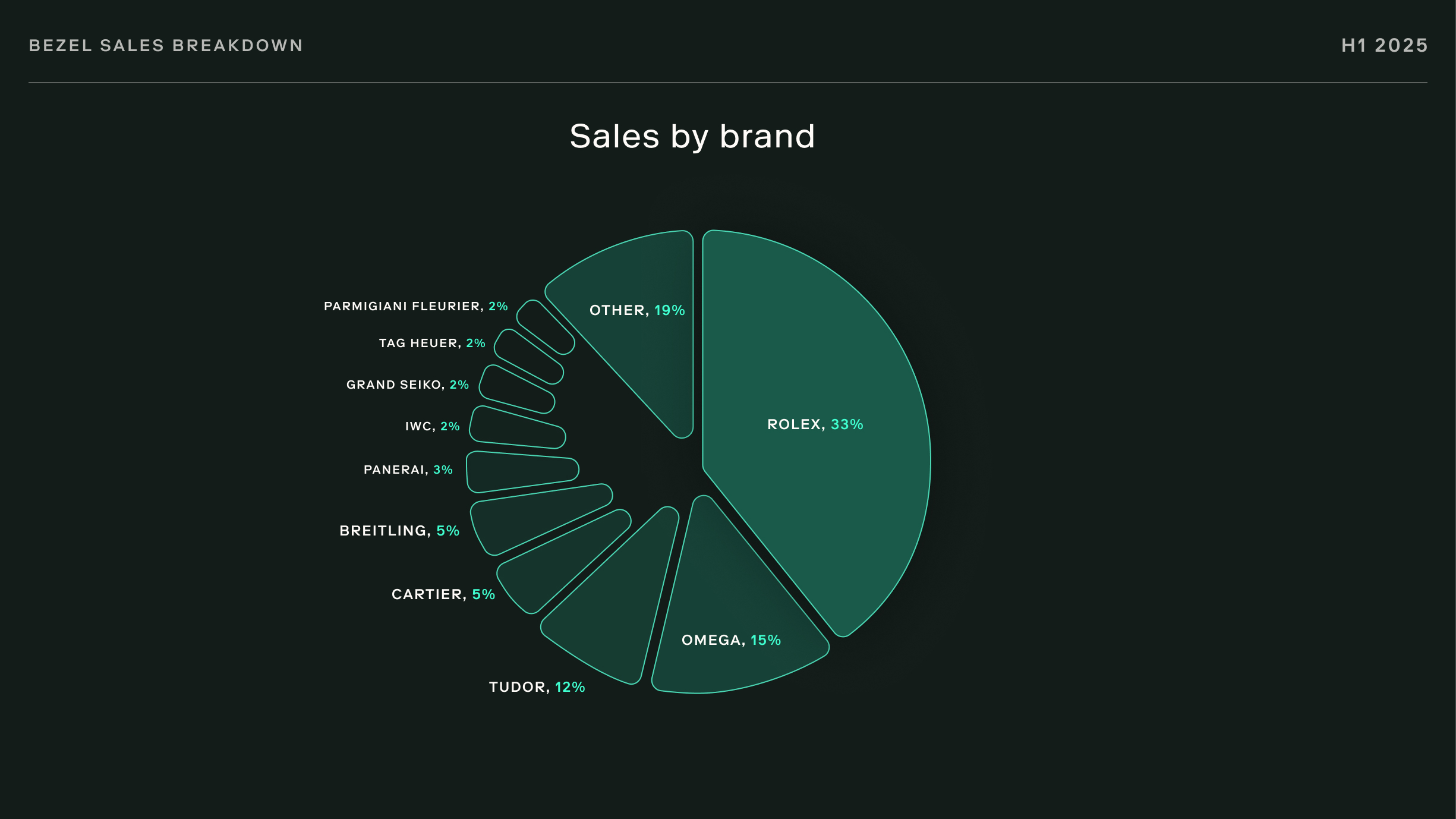
The ultra-luxury segment tells a familiar story. While Patek Philippe and Audemars Piguet each commanded 5% of wants, neither cracked our top sales rankings by volume. These manufacturers continue occupying dream tier territory for the majority of collectors. Perhaps most unanticipated was Parmigiani Fleurier's appearance at 2% of sales without registering meaningful want percentages. This sort of transaction volume represents a significant step forward for an independent brand, indicating that buyers are becoming increasingly aware of Michel Parmigiani’s masterful works of haute horology.
Upon analyzing both wants and sales by release decade over the course of H1 2025, the 2010s emerged as the top decade, accounting for 39% of wants and 41% of sales. This decade's releases barely edged out current production references, which grabbed 36% of wants and 37% of sales. Between these two periods, roughly three-quarters of all platform activity is accounted for.
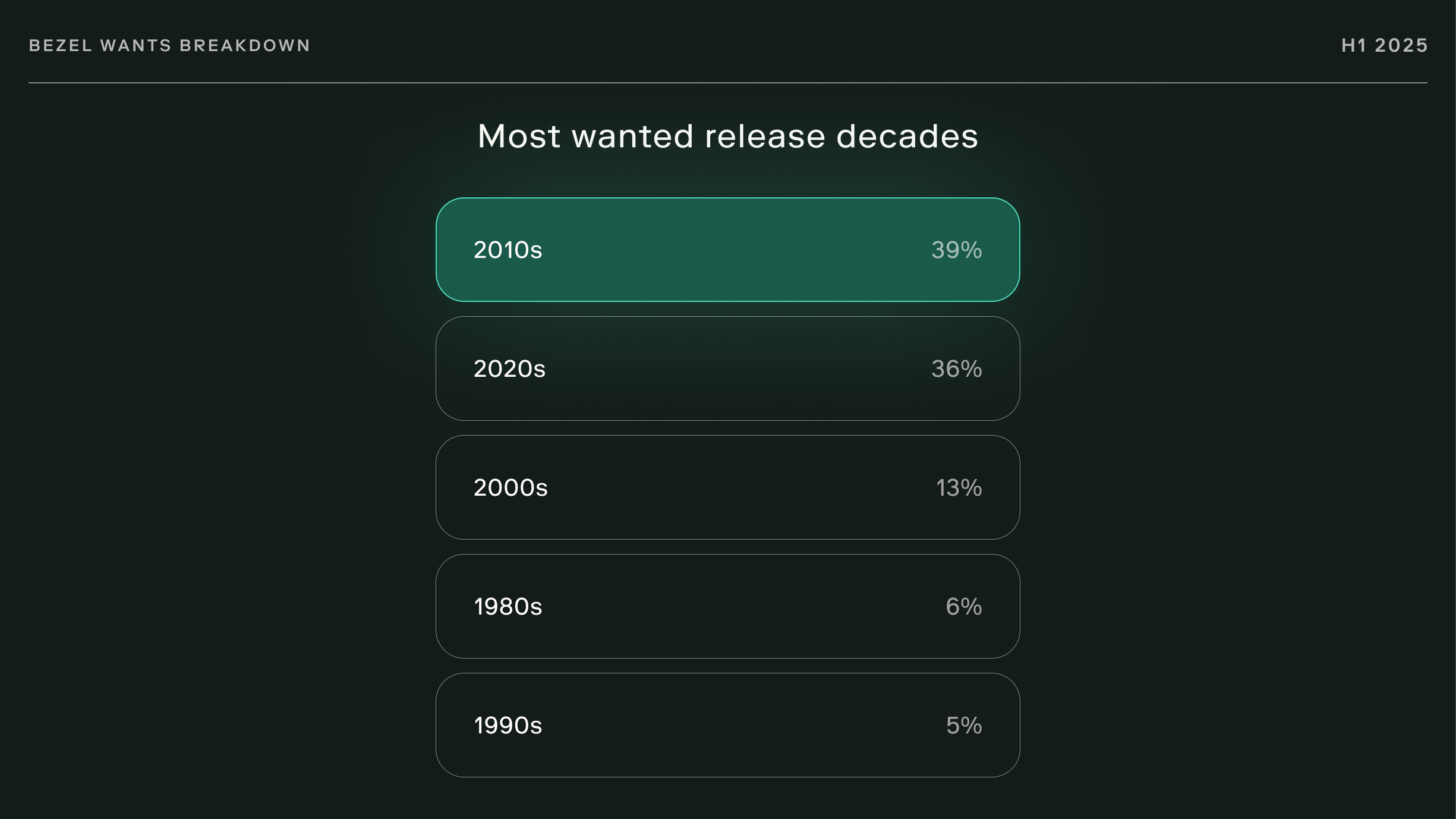
The 2000s held their own, with 13% of wants and 11% of sales, demonstrating a continued appetite for the designs and mechanical innovations of the early aughts. Going further back, the 1980s accounted for 6% of wants and 5% of sales, while releases in the 1990s remained consistent at 5% for both categories. As a result of the platform’s predominant focus on modern and neo-vintage references, vintage references dating back to before 1980 represented just 1% across both metrics. Nonetheless, the market for iconic, well-preserved vintage watches remains robust, and Bezel stands ready to assist collectors in sourcing and selling these pieces.
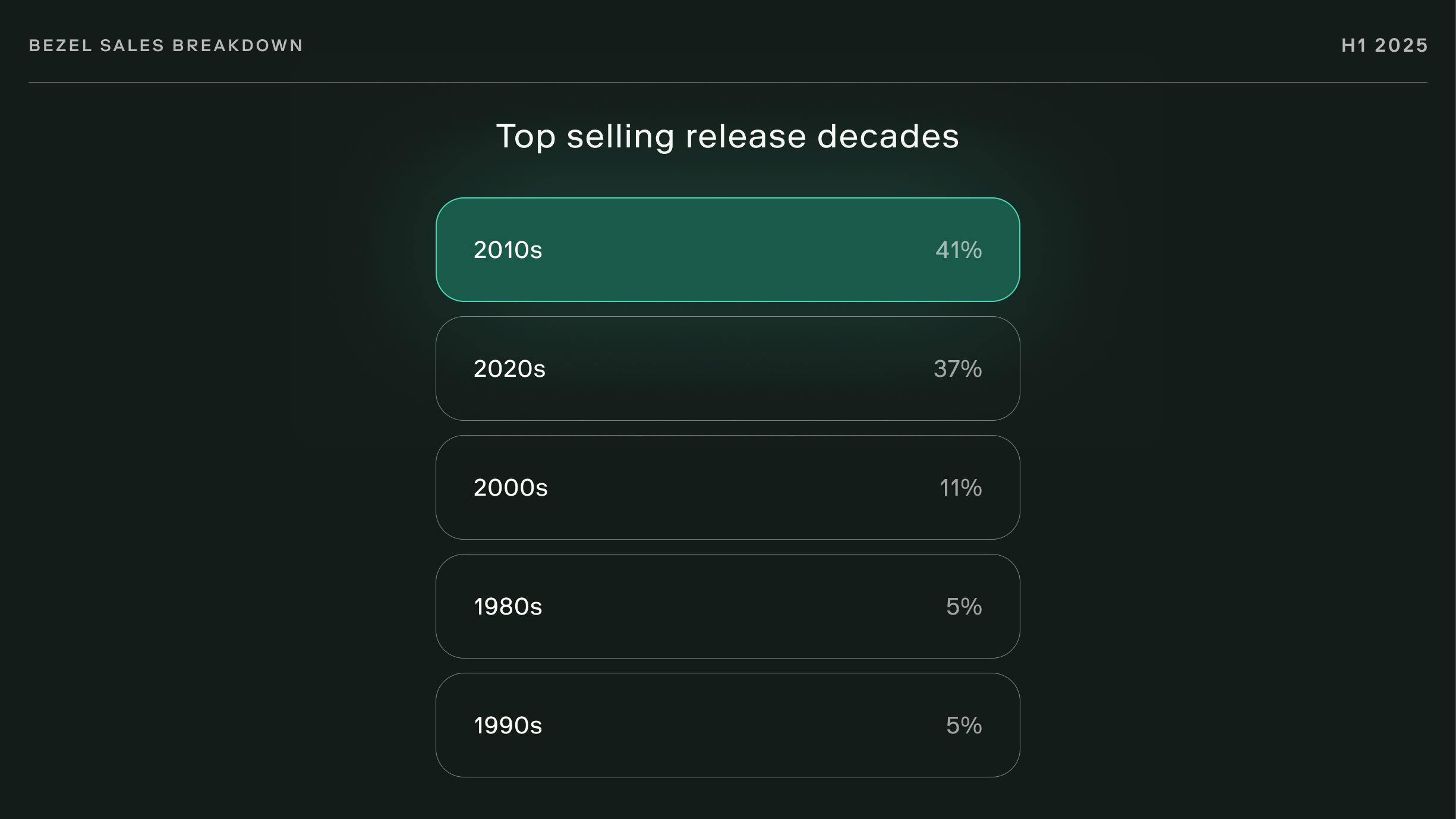
Given the significant role that marketing investments of notable watchmakers play in driving collector enthusiasm, the concentration of interest in watches released in recent decades comes as no surprise.
Data reflecting the dial color preferences of H1 2025 tells a largely similar story to that of 2024’s Bezel Report, with black, blue, and silvered dials securing the majority of collector interest. Likewise, white and green dials are positioned in a closely comparable manner to 2024’s rankings, further suggesting the enduring appeal of versatile tones.
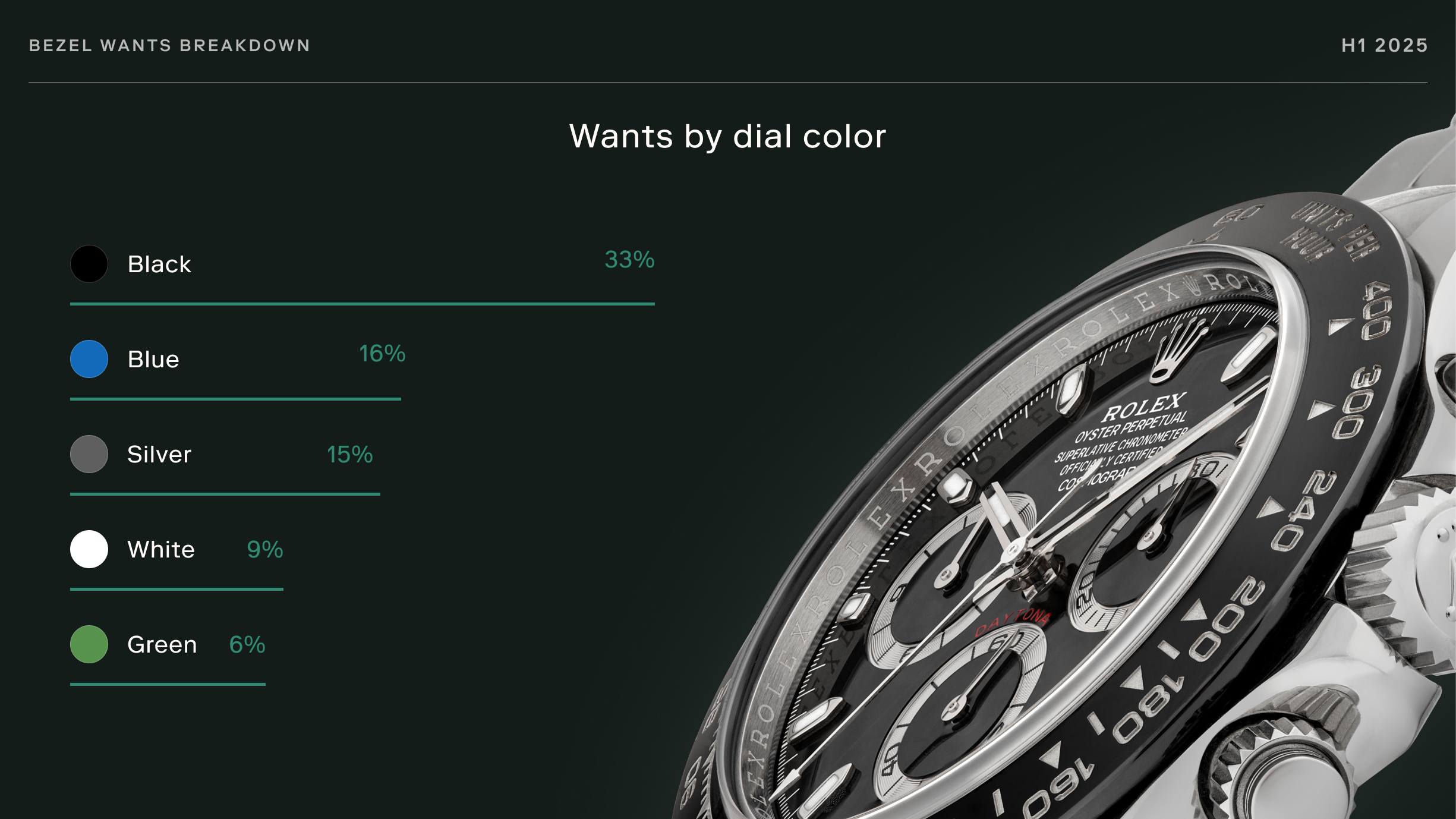
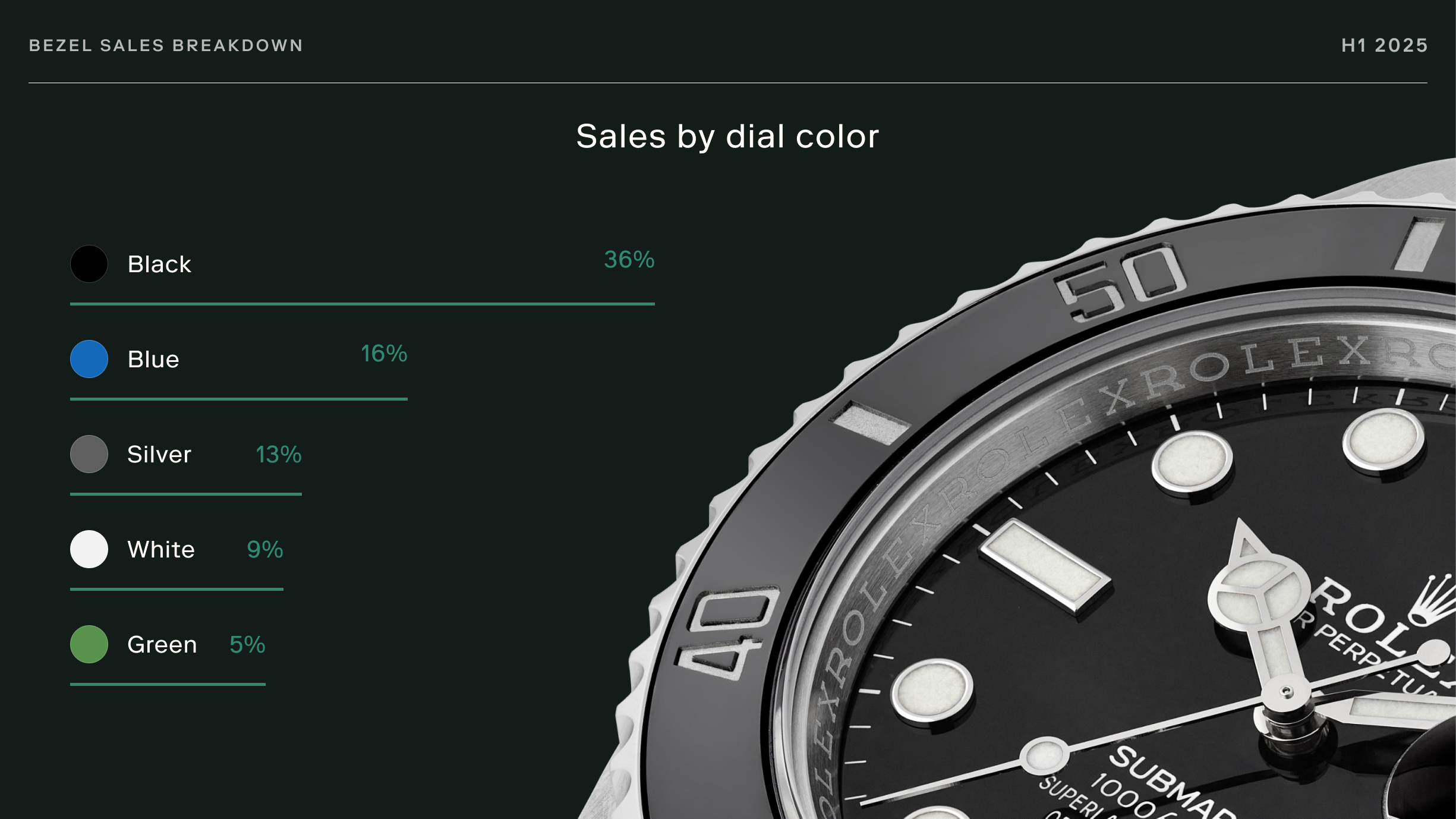
Upon review of the novelties introduced at Watches & Wonders 2025, it’s safe to say that the continued appeal of these dial colors amongst collectors certainly isn’t lost on top watchmakers, including Rolex, Tudor, and Patek Philippe.
The first half of 2025’s case size preferences look largely similar to 2024’s, with a few exceptions worth noting. Forty-millimeter pieces still dominate collector interest, accounting for 24% of wants and 18% of orders, while 41mm pieces held their ground at 21% across both categories.
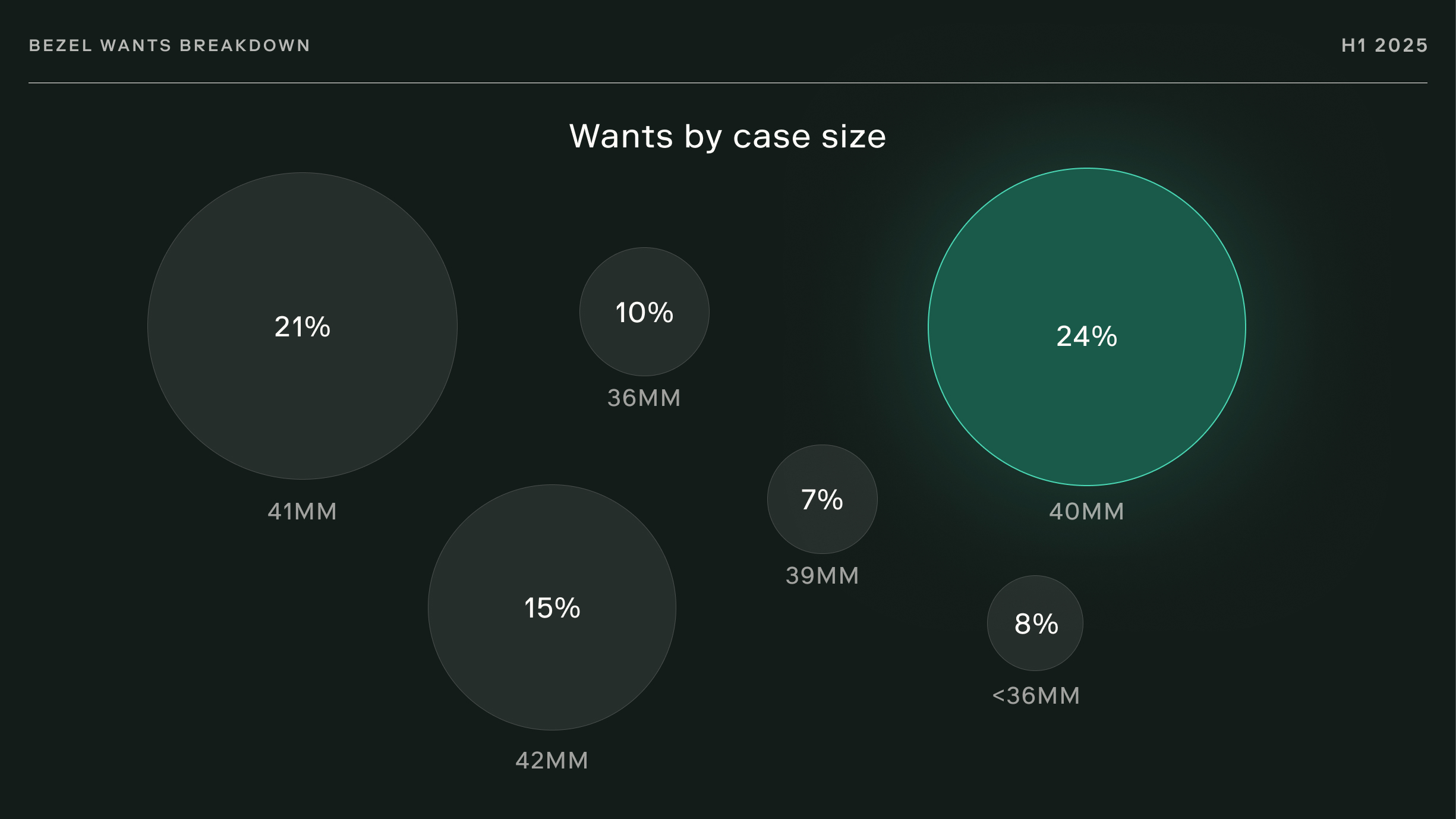
Interest in oversized watches remains significant, with pieces measuring 42mm accounting for 15% of wants and 18% of orders, while those measuring greater than 42mm accounted for 11% of wants and 14% of orders. With that said, 36mm represented 10% of wants and 9% of orders, while those measuring less than 36mm accounted for 8% of wants and 7% of orders.
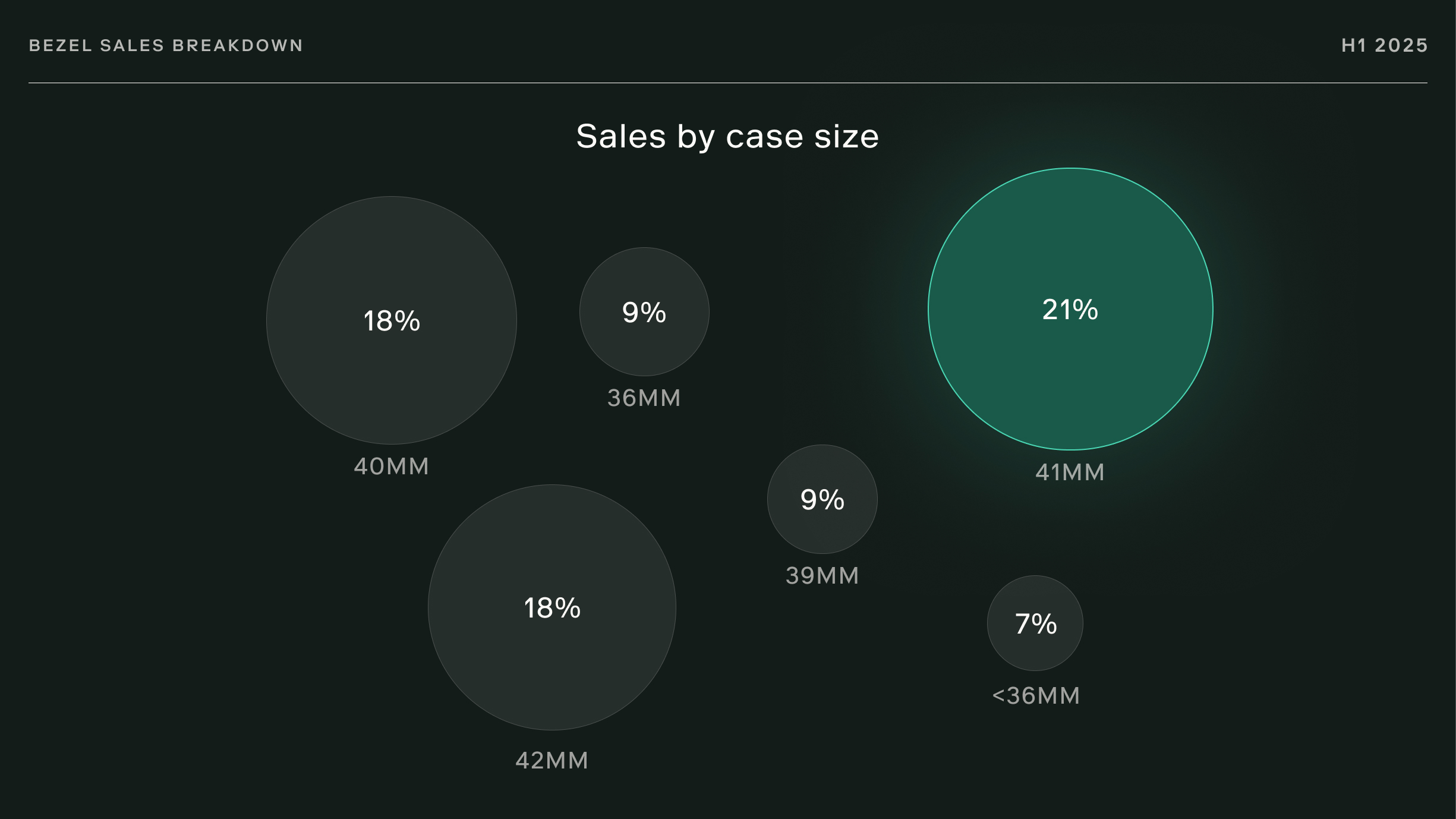
In comparison to the 2024 Bezel Report’s metrics, pieces measuring less than 36mm across experienced a 2% decline in wants and a 3% decline in orders, perhaps suggesting a shift away from smaller watches.
Material preference has shifted notably since the publishing of our 2024 report, with stainless steel extending its already commanding lead. Steel now accounts for 61% of wants, up from 59% the previous year, and an impressive 72% of sales, compared to 69% in 2024. This three-point increase represents the most significant material trend we’ve observed.
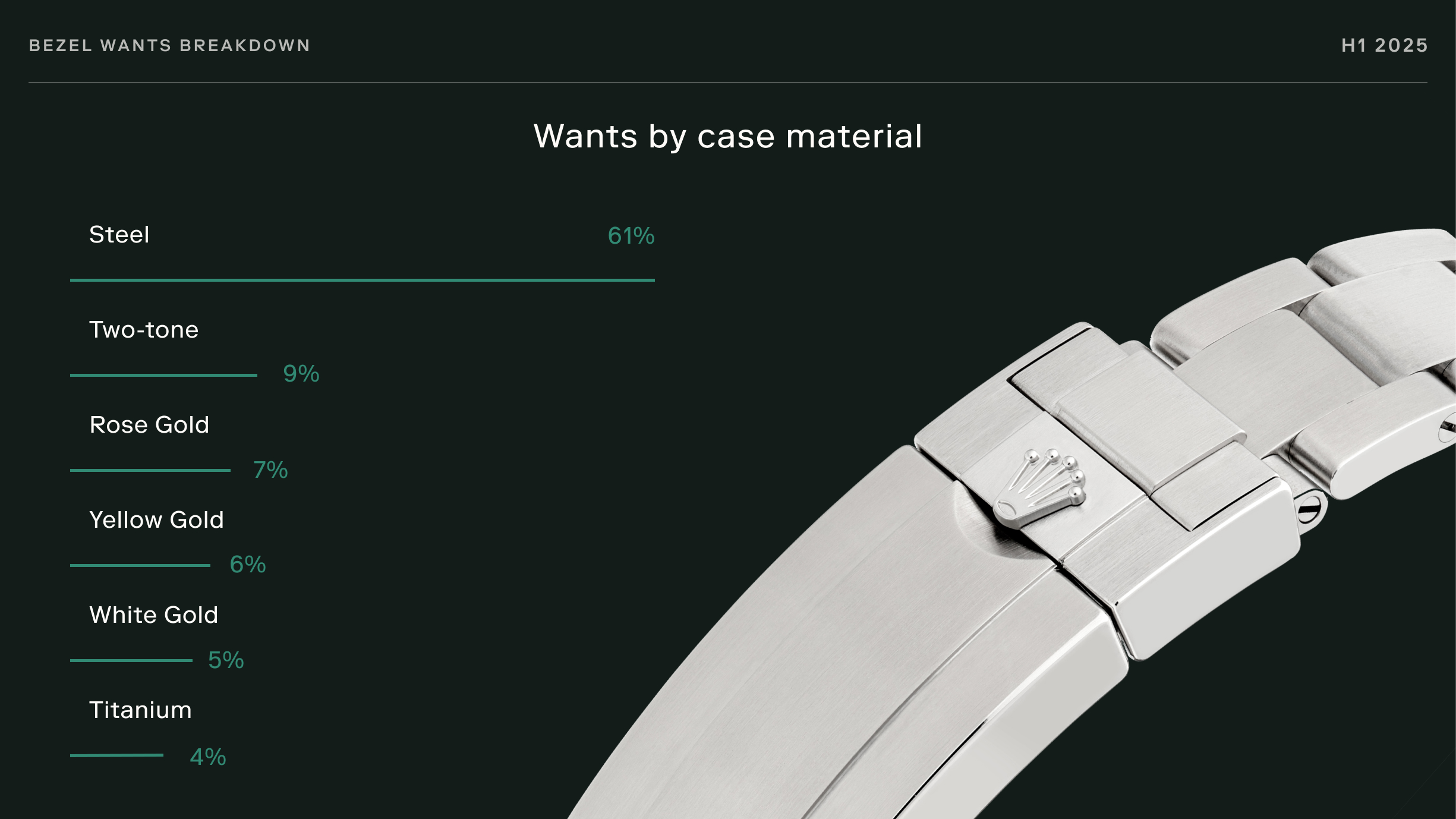
Interest in precious metals experienced a slight decline across the board, with two-tone dropping from 10% to 9% of wants and experiencing a harder hit in sales, falling from 11% to 8%. Rose gold remained steady at 7% of wants, while its sales improved from 3% to 4%. Yellow gold maintained its 6% want share, while declining in sales, accounting for just 2% of total transactions. White gold, similarly, dropped from 5% to 2% in sales, while wants remained at 5%.
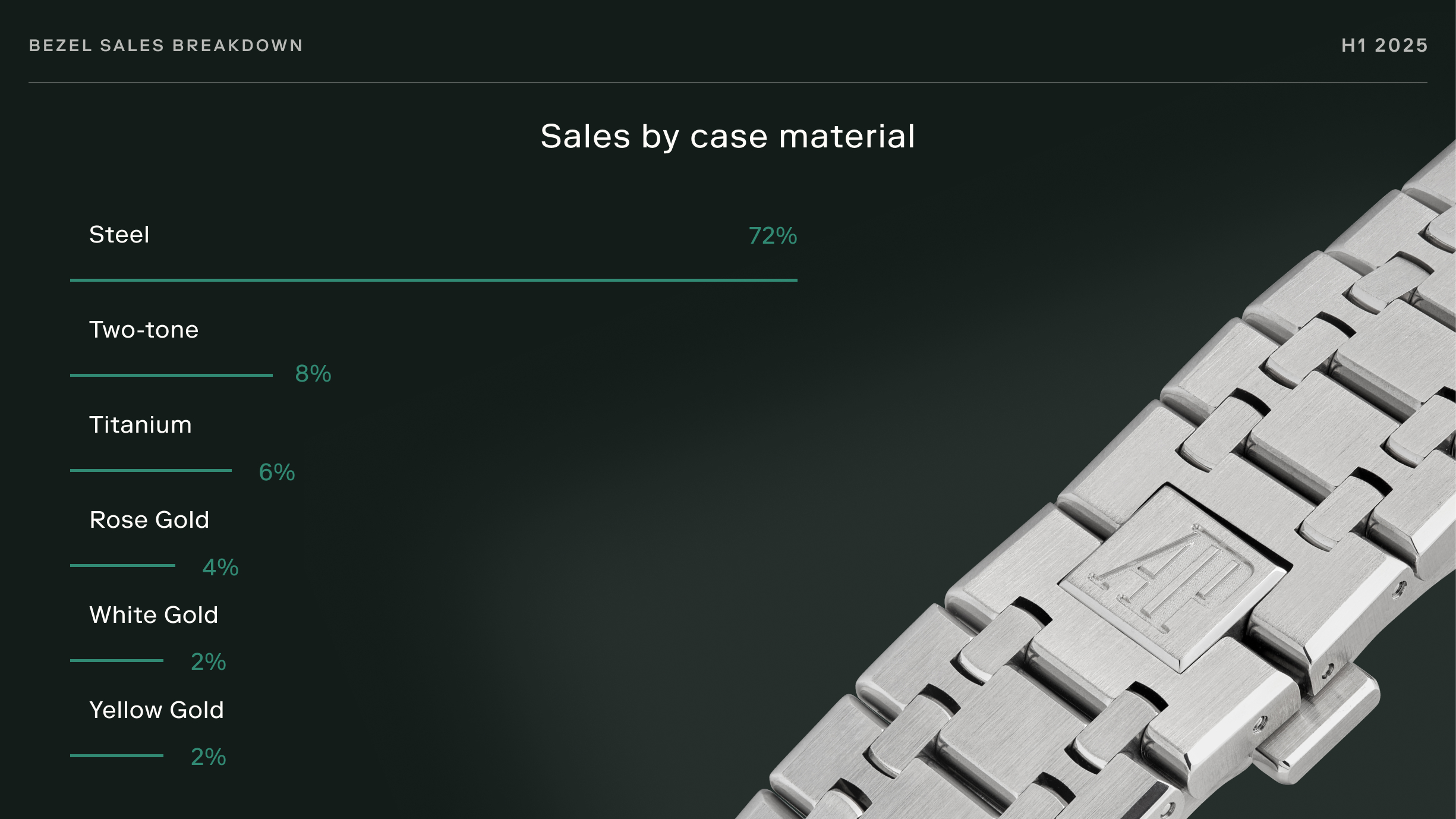
Considering the current economic climate and the appreciation of gold prices, steel’s dominance is logical.
Independent watchmakers and microbrands continue to make their mark on the world of watches, approaching the space with fresh perspectives that manifest in bold designs and innovative approaches, introducing a captivating energy and creativity that allures collectors. Most notably, MB&F, F.P. Journe, Horologer MING, and Rexhep Rexhepi / Akrivia are increasingly capturing the interest of new and established collectors alike with offerings that range from the otherworldly to the meticulously traditional.
This wave of experimentation isn’t limited to new and independent watchmakers; even the most established brands are wading into the realm of statement pieces and embracing bold reinterpretations of their most time-honored designs. For instance, Patek Philippe has begun to incorporate playful and irreverent twists into their iconic complications, now offering several references on denim-style calfskin straps, including the Nautilus Flyback Chronograph Ref. 5980/60G-001, and the World Time Ref. 5330G-001. Similarly, Cartier has leaned fully into maximalism, as evidenced by their heavily gem-set suite of Panthère de Cartier references unveiled at Watches & Wonders 2025. The result is a noticeable eagerness to experiment with expressiveness, while still maintaining a range of understated, elegant designs.
Want to dive deeper into new releases? Check out our coverage of the latest Watches & Wonders 2025 novelties from Rolex, Tudor, Cartier, and Patek Philippe here.
Since the publication of the last Bezel Report recapping 2024, the climate of the luxury watch market has been significantly impacted by the enactment of reciprocal tariffs on Swiss imports, as well as the Swiss Franc’s robust appreciation relative to the US dollar. Together, these consequential factors have significantly shaped the pricing structures of top Swiss watchmakers and influenced the operational strategies of authorized dealers, wholesalers, and secondary market traders.
Following the announcement of a potential 31% levy on imports from Switzerland in April 2025, new watch exports surged as wholesalers and retailers rushed to take delivery of inventory before the adjusted rate’s implementation. Although the final reciprocal tariff rate was ultimately lower than initially proposed (with a standing blanket rate of 10% in place as trade agreement negotiations continue), this surge wasn’t confined to Swiss imports alone. Given that a substantial portion of pre-owned inventory from Asia and Europe flows into the US secondary market, these circumstances have created a ripple effect, influencing pricing strategies and market behavior both within the US and globally.
Ryan Chong, Bezel’s Chief Marketplace Officer, explains, “The second-order effects of the tariff implementation have resulted in higher prices for the newest models across all Swiss brands. As they remain in place, there are fewer imports resulting in fewer examples for sale, and thus prices that are rising by the week. April and May also saw retail price increases from many brands, contributing to this effect.”
For those individuals currently holding sought-after timepieces, these market tailwinds may present a prime opportunity to achieve a stronger resale value than in previous months.
While new trends are indeed emerging, and economic developments are undeniably impacting the ease with which collectors acquire watches, little can shake the allure and demand for iconic designs that have long defined the horological landscape. Even as newcomers vie for and often successfully acquire market share, sought-after Rolex sports models, such as the Submariner, GMT-Master II, and Daytona, along with historically significant pieces like the Omega Speedmaster “Moonwatch,” continue to dominate the interests of collectors. This sentiment is echoed regularly through our monthly publication of the most-wanted watches on the platform, previously issued in March, April, and May of this year.
Ultimately, this enduring appeal can be attributed to decades of frenzied fascination, unrivaled pop-cultural associations, and a legacy of craftsmanship that continues to resonate with collectors worldwide. Not only do these timepieces remain highly coveted and synonymous with watchmaking as a whole, but they also set the standard to which new releases are measured.
Before the digital age, watch collecting was a categorically antiquated interest, attracting a very different crowd through much slower means, including forums, private collector events, and traditional print media campaigns. This starkly contrasts the fast-paced, online-centric environment we see today. Though retail boutiques and collector events remain an integral component of today’s watch-collecting landscape, social media now plays a pivotal role in shaping tastes and trends, amplifying the reach and impact of the horological community on a global scale.
With a seemingly never-ending stream of near-instantaneous, visually stimulating content being posted on social platforms, collectors now discover trends, familiarize themselves with new releases, and pay attention to what’s adorning noteworthy wrists around the clock, in real time. Furthermore, algorithms enable the rapid development of certain styles, brands, and references, resulting in overnight sensations that translate into market shifts.
Taking the place of online forums, the watch-collecting community now calls Instagram and TikTok home, enlivening the culture and commerce of horology like never before.
Learn more about social media’s continued influence on watch collecting here.
While wristwatches were, in fact, initially intended for females, historically offering a more jewelry-like alternative to pocket watches of old, we’d be remiss to suggest that the watch-collecting communities of the last several decades had a significant female presence. They were instead male-dominated by nature. We’re enthused to report that this is all drastically changing, and at an excitingly fast pace.
With the passing of each and every second, more brands have begun speaking to women not through pink-dial playbook clichés or a limited selection of downsized men’s models, but with thoughtfully designed pieces, and sincere marketing characterized by style, substance, and an understanding that taste doesn’t follow gender lines.
This shift has been advanced in no small way by the rapidly increasing number of outspoken female voices in the watch-collecting world. Alongside influencers like Brynn Wallner of Dimepiece, Georgia Benjamin, and Jennifer Leingang, also known as Jenni Elle, editorial voices such as Hodinkee’s Malaika Crawford and Revolution’s Suzanne Wong enrich the horological narrative, democratizing the space and inviting a broader, more representative audience.
Learn more about how women are redefining the watch-collecting landscape here.
Throughout the first half of 2025, celebrities dominated both watch media and the broader media landscape with notable watch-spotting moments, demonstrating thoughtful choices and an increasing degree of obsession with all things watches. Although red-carpet events naturally delivered an impressive display of timepieces, some of the year's best celebrity watch spotting took place in more casual settings, indicating the degree to which important luxury watches factor into the lives of today's most notable names.
Cartier emerged as a top celebrity choice throughout this period. Timothée Chalamet went all-in on the Maison, wearing a Baignoire "Byzantine" to the Oscars, showing up with a pink-dial Ballon Bleu de Cartier at the Berlin premiere of A Complete Unknown, and making waves with two stacked Tank Louis Cartier “Mini” watches at the Palm Springs International Film Festival.
Notably, Chalamet and Kylie Jenner were both spotted sporting Cartier watches courtside at Knicks playoff games, further cementing the brand’s status as a celebrity favorite. The Jenner sisters continued to champion Cartier trend in their own distinct ways. Kylie was consistently spotted wearing the newly introduced Panthère de Cartier Ref. WJPN0060, while Kendall went with a white gold Crash featuring a salmon dial for the Indian Wells Open. Musicians Jhené Aiko and Lana del Rey also jumped on the Baignoire trend through well-placed social media moments.
Rolex stayed relevant through both official partnerships and natural celebrity choices. Leonardo DiCaprio's appointment as an official Rolex Testimonee was a significant development, further strengthening the legendary watchmaker’s Hollywood ties. The organic sightings continued with Kevin Hart wearing a yellow gold Daytona "Le Mans" (Ref. 126528LN) courtside at the Nuggets-Clippers game, while Ed Sheeran chose the white gold version (Ref. 126529LN) for the 2025 Time 100 Gala. Pusha T later stole the show with a rose gold Daytona “Rainbow” Ref. 116595RBOW-0001 at the Met Gala, effectively demonstrating how the Daytona remains the Rolex to have across various entertainment worlds.
At the relatively more accessible, albeit still star-studded end of the spectrum, Tudor’s significance was further supported in no small part by the watchmaker’s continued association with David Beckham. The brand strategically partnered with the legendary footballer to tease the Black Bay Chrono “Flamingo Blue” via a pre-release Instagram tease, which was immediately met with a great deal of fanfare and fervor. Omega, too, flexed their sporting associations throughout April’s Masters Tournament, where Rory McIlroy, an Omega brand ambassador, notably donned the Speedmaster “Silver Snoopy Award” 50th Anniversary upon claiming his first green jacket.
Female celebrities and high-end watches created some interesting dynamics during this period. DJ Peggy Gou has been consistently spotted wearing traditionally masculine Patek Philippe pieces - both a stainless steel Aquanaut Ref. 5167A-001 and a rose gold Nautilus Moon Phase Ref. 5712/1R-001, demonstrating how women are choosing watches based on their personal preferences, rather than what is expressly marketed to them. On the other hand, Hailey Bieber showcased exceptional women's pieces, including her white gold Audemars Piguet Mini Royal Oak "Frosted Gold" paired with Marine Serre during a Miami Grand Prix event, and a vintage white gold Audemars Piguet with diamonds and an opal dial at the Met Gala.
The overall trajectory suggests a substantial maturation in celebrity watch culture, with timepieces increasingly serving as sophisticated instruments of personal expression rather than mere status indicators.
The first half of 2025 has been a period of significant growth for us, allowing us to achieve new milestones. As we look forward to the remainder of the year and 2026, we’re excited to constantly improve our existing product experience, double down on trust, and broaden the set of tools in the Bezel suite to scale our impact on all of our users’ collecting journeys.
We’ve always viewed ourselves as the technology platform for watches, so I’m very excited to share more about what that means in our next report!
Bezel is the top-rated marketplace for buying and selling luxury watches. We give you access to tens of thousands of the most collectible watches from the world's top professional sellers and private collectors. Every watch sold goes through our industry-leading in-house authentication process, so you can buy, sell, and bid with confidence.
Download the Bezel app on the iOS App Store or start searching for your next watch today at getbezel.com.
Bezel is available to download on the App Store now. Please reach out to our concierge team if there is anything we can help you with!